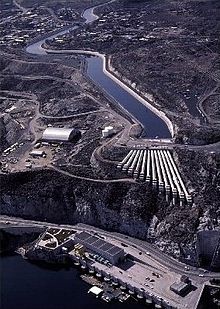The dam's primary goal, irrigation, was postponed as the wartime need
for electricity increased. The dam's powerhouse began production around
the time
World War II began, and its electricity was vital to the war effort. The dam powered aluminum
smelters in
Longview and
Vancouver, Washington,
Boeing factories in
Seattle and Vancouver, and Portland's shipyards. In 1943, its electricity was also used for
plutonium production in
Richland, Washington, at the
Hanford Site, which was part of the top-secret
Manhattan Project.
[73][74] The demand for power at that project was so great that in 1943, two generators originally intended for the
Shasta Dam were installed at Grand Coulee in an effort to hurry the generator installation schedule.
[75]
Irrigation
Water is pumped via the Pump-Generating Plant's 12-foot (3.7 m) diameter pipes 280 ft (85 m) from
Lake Roosevelt
to a 1.6 mi (2.6 km) feeder canal. From the feeder canal, the water is
transferred to Banks Lake which has an active storage of 715,000
acre·ft (882,000,000 m
3). The plant's twelve 65,000–70,000 horsepower pumps can transfer up to 1,605 cu ft/s (45 m
3/s) to the lake. Currently, the Columbia Basin Project irrigates 670,000 acres (2,700 km
2) with a potential for
1.1 million.
[68] Over 60 different crops are grown within the project and distributed throughout the United States.
[58]
Power
Grand
Coulee Dam supports four different power houses containing 33
hydroelectric generators. The original Left and Right Powerhouses
contain 18 main generators and the Left has an additional three service
generators for total installed capacity of 2,280 MW. The first generator
was commissioned in 1941 and all 18 were operating by 1950. The Third
Powerplant contains a total of six main generators with a 4,215 MW
installed capacity. Generators G-19, G-20 and G-21 in the Third
Powerplant have a 600 MW installed capacity but can operate at a maximum
capacity of 690 MW which brings the overall maximum capacity of the
dam's power facilities to 7,079 MW. The Pump-Generating Plant contains
six pump-generators with an installed capacity of 314 MW. When pumping
water into Banks Lake they consume 600 MW of electricity. Each generator
is supplied with water by an individual
penstock. The largest of these feed the Third Powerplant and are 40 ft (12 m) in diameter and can supply up to 35,000 cu ft/s (990 m
3/s).
The dam's power facilities originally had an installed capacity of
1,974 MW but expansions and upgrades have increased generation to
6,809 MW installed, 7,079 MW maximum. In 2014, 20.24 TWh of electricity
was generated, resulting in a
plant factor of 35%.
[2]
Hydroelectric generators at Grand Coulee Dam[76]
| Location |
Type |
Quantity |
Capacity (MW) |
Total capacity (MW) |
| Left Powerhouse |
Francis turbine, service generator |
3 (LS1-LS3) |
10 |
30 |
| Francis turbine, main generator |
9 (G1-G9) |
125 |
1,125 |
| Right Powerhouse |
Francis turbine, main generator |
9 (G10-G18) |
125 |
1,125 |
| Third Powerplant |
Francis turbine, main generator |
3 (G22-G24) |
805 |
2,415 |
| Francis turbine, main generator |
3 (G19-G21) |
600 (Max: 690 MW) |
1,800 |
| Pump-Generating Plant |
Pump-generator, peak generator |
4 (PG9-PG12) |
53.5 |
214 |
| Pump-generator, peak generator |
2 (PG7-PG8) |
50 |
100 |
| Totals |
|
33 |
|
6,809 |
Spillway
Pump-Generating Plant and Roosevelt Lake at bottom, feeder canal to Banks Lake at top
Grand Coulee Dam's
spillway is 1,650 feet (500 m) long and is an overflow, drum-gate controlled type with a 1,000,000 cu ft/s (28,000 m
3/s) maximum capacity.
[69] A record flood in May and
June 1948 flooded lowland below the dam and highlighted its limited flood control capability at the time,
[77] as its spillway and turbines hit a record flow of 637,800-cubic-foot-per-second (18,060 m
3/s).
[68] The flood damaged downstream riverbanks and deteriorated the face of the dam and its
flip bucket at the base (toe) of the spillway.
[78]
The flood spurred the Columbia River Treaty and its provisions for dams
constructed upstream in Canada, which would regulate the Columbia's
flow.
[79]
Cost benefits
The
Bureau of Reclamation
in 1932 estimated the cost of constructing Grand Coulee Dam (not
including the Third Powerplant) to be $168 million; its actual cost was
$163 million ($1.85 billion in 1998). Expenses to finish the power
stations and repair design flaws with the dam throughout the 1940s and
'50s added another $107 million, bringing the total cost to $270 million
($2.6 billion in 1998), about 33% over estimates.
[80] The Third Powerplant was estimated to cost
$390 million in 1967, but higher construction costs and labor disputes drove the project's final cost in 1973 to
$730 million (
$2.93 billion
in 1998), about 55% over estimates. Despite estimates being exceeded,
the dam became an economic success, particularly with the Third
Powerplant exhibiting a benefit-cost ratio of 2:1.
[63]
Although Reclamation has only irrigated about half of the land
predicted, the gross value of crop output (in constant dollars) had
doubled from 1962 to 1992, largely due to different farming practices
and crop choices.
[36] The Bureau expects the money earned from supplying power and irrigation water will pay off the cost of construction by 2044.
[81]

No comments:
Post a Comment